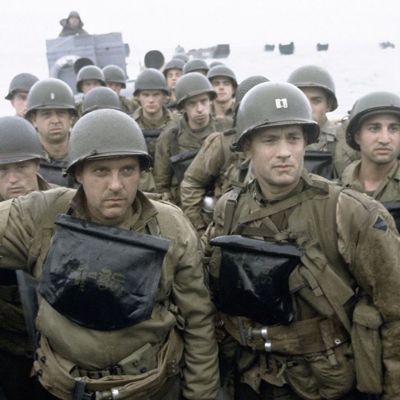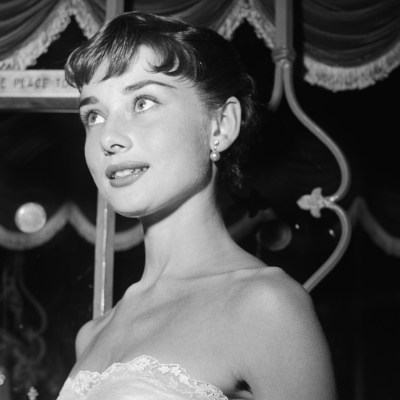How Saving Private Ryan Influenced Medal of Honor and Changed Gaming
The desire to make a video game as good as Saving Private Ryan led to the Medal of Honor franchise and the future of gaming.
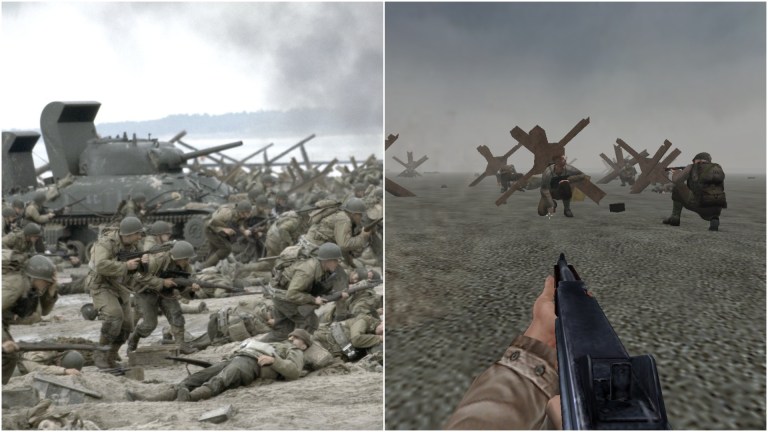
The legacies of Medal of Honor and Saving Private Ryan have gone in wildly different directions since the late ’90s. The latter is still thought of as one of the most influential and memorable movies ever made. The former is sometimes referred to as a “Did You Know?” piece of Call of Duty‘s history or maybe just proof the PS1 had a couple of good first-person shooters.
It wasn’t always that way, though. There was a time when the fates of Medal of Honor and Saving Private Ryan seemed destined to be forever intertwined. After all, Medal of Honor was essentially pitched as the game that would do to WW2 games what Saving Private Ryan did for WW2 films.
That never quite happened, but the ways that the fates of those two projects began, diverged, met, and ultimately split helped shape the future of gaming in ways you may may not know about.
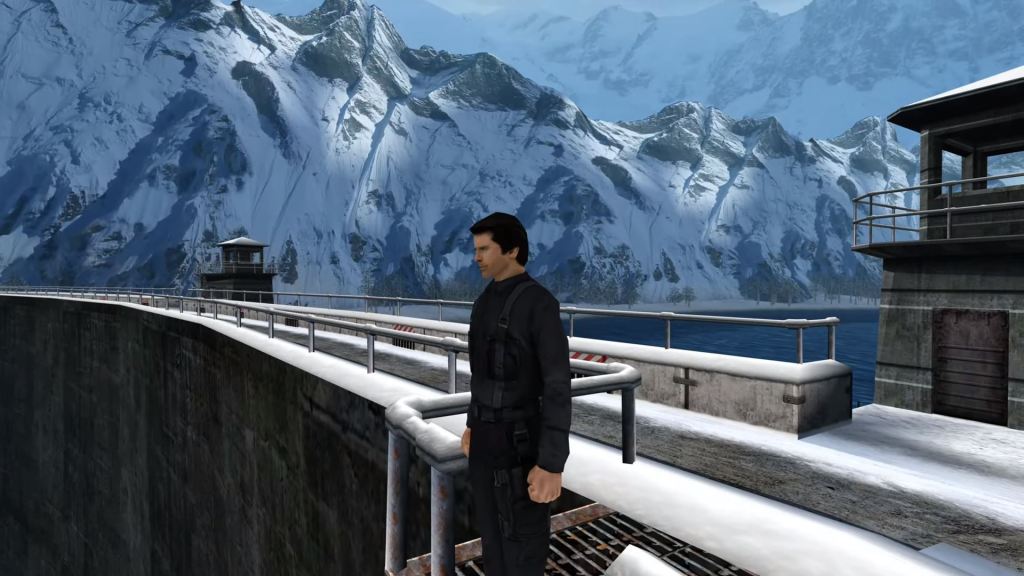
Steven Spielberg’s Son and GoldenEye 007 Change the Fate of the WW2 Shooter
In case Ready Player One didn’t make it clear, Steven Spielberg has always loved video games. While you’d think that the reception to 1982’s E.T. for the Atari (a game so bad that millions of unsold copies were infamously buried in a landfill) would have soured him on the format, Spielberg remained convinced that gaming was going to play a big role in the future of storytelling and entertainment. Spielberg even co-wrote a sometimes overlooked 1995 LucasArts adventure game called The Dig.
It was around that same time that Spielberg also expressed his interest in making a video game based on his fascination with WW2. In fact, in the early ‘90s, designer Noah Falstein started working on a WW2 game after a conversation with Spielberg reportedly piqued his own interest in that idea.
The project (which was known as both Normandy Beach and Beach Ball at the time) was fascinating. It would have followed two brothers participating in the D-Day invasion: one on the beaches of Normandy and one who was dropping in behind enemy lines. Players would have swapped between the two brothers (try to push aside any Rick and Morty jokes for the moment) as they fought through the war and finally saw each other again.
It was a great idea, but when Falstein took it to DreamWorks Interactive (the gaming division of the DreamWorks film studio that Spielberg co-owned), he was surprised to be greeted with a cold shoulder. It seems that the DreamWorks Interactive team felt it would be hard to sell a game to kids that was based on a historical event as old as WW2. Work on the project quietly ended months after it had begun.
While it’s probably wild to think of a game designer that had a hard time pitching a WW2 game in the ‘90s, you have to remember that widespread cultural interest in WW2 at that time was still fairly low. There were WW2 games released prior to that point, but most of them either made passing references to the era (such as Wolfenstein) or were hardcore strategy titles typically aimed at an older audience. Most studios believed that kids wanted sci-fi and fantasy action games, and many of them weren’t willing to invest heavily on the chance they were wrong.
Spielberg shared that concern, but he saw it slightly differently. As someone who believed that WW2 was this event that shaped the generation that lived through it and those that came after, he felt this desire to inform people of the war’s impact and intrigue through the considerable means and talent available to him. That strategy obviously included Saving Private Ryan, but he was especially interested in reaching that same young audience that DWI felt would largely ignore a WW2 game.
Legend has it that a lightbulb went off in Spielberg’s head as he watched his son play GoldenEye 007 for N64. Intrigued by both his son’s fascination with that shooter, and the clear advances in video game technology it represented, he took time away from Saving Private Ryan’s post-production process, visited the DWI team, and told them that he wanted to see a concept for a WW2 first-person shooter set in Europe and named after the Medal of Honor. If the team wasn’t stunned yet, they certainly would be when Spielberg told them that they had one week to show him a demo.
Doubtful that they could produce a compelling demo in such a short amount of time, doubtful the PS1 could handle such an ambitious FPS concept, and still very much doubtful that gamers wanted to play a WW2 shooter, the team reworked the engine for the recent The Lost World: Jurassic Park PlayStation game and used it as the basis for what was later described as a shoestring proof of concept.
It may have been pieced together, but what DWI came up with was enough to excite Spielberg and, more importantly, excite the game’s developers. Suddenly, people were starting to buy into the idea that this whole thing could work and was very much worth doing. As the calendar turned to 1998 and Saving Private Ryan became a blockbuster that was also changing the conversation about World War 2, it suddenly felt like the DWI team might just have a hit on their hands.
Unfortunately, not everyone was on board with the idea, and those doubts would soon change the trajectory of the game.
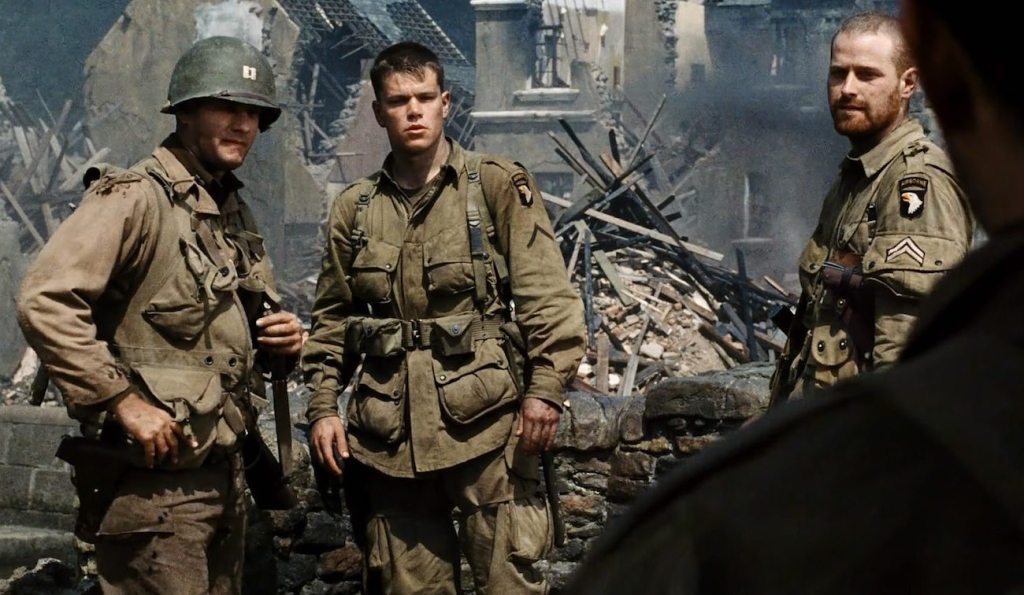
Columbine and Veteran Concerns Force Medal of Honor to Move Away from Saving Private Ryan
Saving Private Ryan was widely praised for its brutal authenticity that effectively conveyed the horrors of war, as well as its technical accomplishments that changed the way films are made and talked about. At first, it seemed like the Medal of Honor team intended to attempt to recreate both of those elements.
On the technical side of things, the developers were succeeding in ways that their makeshift demo barely suggested was possible. While the team was right that developing an FPS on PlayStation meant working around certain restrictions (they couldn’t get daytime levels to look right so everything in the original game happens at night), the PlayStation proved to be remarkably capable in other ways. Because the team was limited from a purely visual perspective, they decided to focus on character animations and AI in order to “sell” the world.
While they’re easy to overlook now, the original Medal of Honor did things with enemy AI that few gamers had seen at the time. Enemies reacted to being shot in ways that suggested they were more than just bullet sponges. They’d drop their weapons, lose their helmets, scramble for cover…it all contributed to the sensation of battling actual humans. Well, not actual humans but rather Nazis. In fact, the thrill of feeling every bullet you fired at Nazis was one of the things that excited the team early on. Both developers and players fondly recall being able to do things like make a dog fetch a grenade and take it back to his handler to this day.
Just as it was in Saving Private Ryan, sound design was a key part of what made Medal of Honor work. Everything ricocheted and responded with a level of authenticity that perfectly complemented the film-like orchestral score that they had commissioned from game composer Michael Giacchino. The quality of the game’s sound is partially attributed to the contributions of Captain Dale Dye who helped ensure the authenticity of Saving Private Ryan and did the same for Medal of Honor. Initially, Dye was doubtful the game could be on the same level as the film.
Actually, Dye’s feedback was one of the earliest indications that some veterans were going to be very apprehensive of the idea of turning war into a video game like Medal of Honor. Dye eventually saw that their intentions were good, but the team soon received another wake-up call when Paul Bucha, a Medal of Honor recipient and then-president of the Congressional Medal of Honor Society, wrote a letter to Steven Spielberg that essentially shamed him for his involvement with the game and demanded that he remove the Medal of Honor name from the project. At that point in development, such a change could have meant the project’s cancellation.
That wasn’t the only problem that suddenly emerged. In April 1999 (six months before Medal of Honor’s release), the Columbine High School massacre occurred and changed the conversation about violence in entertainment (especially video games). Reports indicate that Medal of Honor was, at that time, a particularly violent video game clearly modeled after the brutality of Saving Private Ryan that also featured an almost comical level of blood that some who saw the early versions of the title compared to The Evil Dead. Suddenly, the team felt apprehensive of what they had been going for.
These events and concerns essentially encouraged the Medal of Honor team to step away from Saving Private Ryan a bit and focus on a few different things that would go on to separate the game from the film it was spiritually based on.
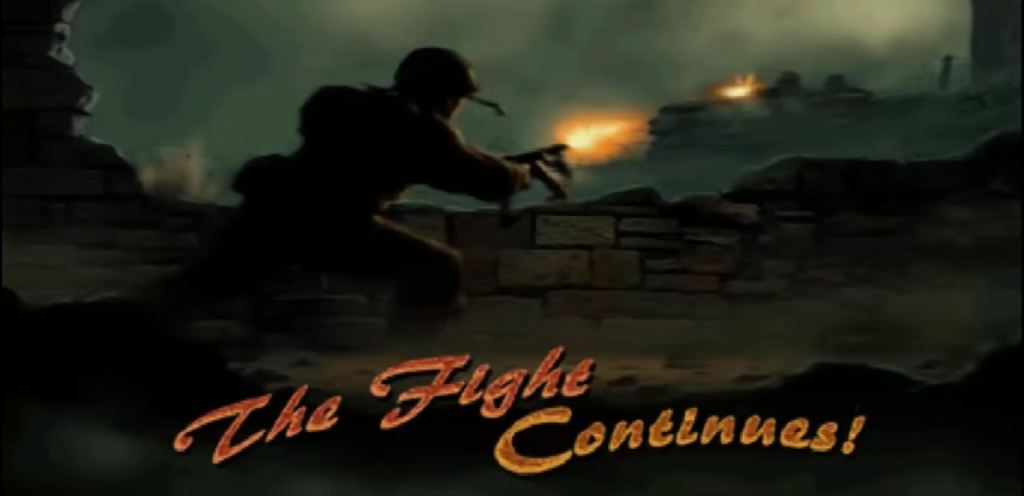
Medal of Honor: A Different Kind of War Game
It was easy enough to cut Medal of Honor’s violence (or at least its gore), but when it came to addressing concerns of the game’s commercialization and gamification of war and the experience of soldiers, the team found some more creative solutions.
For instance, you may notice that the original Medal of Honor is a much more “low-key” shooter and WW2 game compared to other titles at the time and those that would follow. Well, part of that tone was based on Spielberg’s desire to have the game tell more of a story through gameplay than other shooters had done up until that point (an innovation in and of itself), but a lot of that comes from the input of Dale Dye.
As Dye taught the team what it was like to be a soldier and serve during WW2, they gained a perspective that they felt the need to share. This is part of the reason why Medal of Honor features a lot of text and cutscene segments designed to teach parts of the history of the war that would have otherwise likely been left on the cutting room floor. There’s a documentary feel to that title that you still don’t see in a lot of period-specific games.
That decision may have also helped saved Medal of Honor in the long run. When Bucha raised his concerns about the project, the team took them seriously enough to consider canceling the game just months before its release. However, producer Peter Hirschmann extended an invite to Bucha so that he could see what exactly it was that they were working on.
It was a bold move that proved to pay off as Bucha was so impressed with the game’s direction (a direction that changed drastically in development) that he actually ended up officially supporting the title. Maybe it wasn’t as grand and impactful as Saving Private Ryan, but he saw the team was doing something that was so much more than just a high score and gore.
Medal of Honor proved to be a hit in 1999, but the celebration was impacted by the news that DWI had been sold to EA. The good news was that most of the key members of the DWI team were able to stay together to work on 2000’s Medal of Honor: Underground: a criminally overlooked game that told a brilliant story about a French Resistance fighter modeled after the legendary Hélène Deschamps Adams. That game advanced the unique style of the original game and retained its quality. I highly recommend you play it if you’ve never done so.
Soon, though, everything would change in a way that brought the series directly back to Saving Private Ryan in ways that are stil being felt to this day.
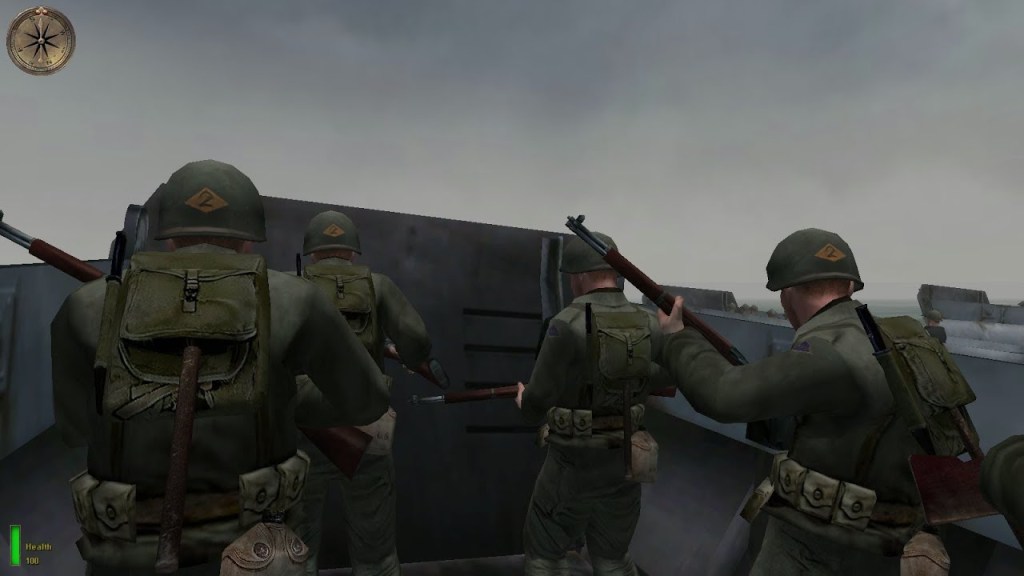
Medal of Honor: Allied Assault – The (Mostly) Unofficial Saving Private Ryan Game
EA decided to continue the Medal of Honor series but without the old Medal of Honor team at the helm. The story goes that they initially asked id Software to develop the next Medal of Honor game, but the id team said they were too busy and instead recommended they ask a studio called 2015 Games to further the franchise.
Never heard of them? I’m not surprised. The team’s previous work hadn’t set the world on fire, but EA took id’s recommendation to heart and asked the young developers to start working on what would become 2002’s Medal of Honor: Allied Assault.
It’s funny, but for such an important game, we really don’t know a lot about the details of Allied Assault’s development. It’s been said that the game’s development was pretty rough (the young team apparently struggled to combine their separate ideas under one creative vision), and we also know that they contacted Dale Dye for authenticity input just as the DWI team had done.
What we don’t exactly know is why Allied Assault was designed to so closely resemble Saving Private Ryan.
It’s easy to assume that the developers were just big fans of the movie (who wasn’t back then?), but there are elements of Allied Assault that are essentially pulled directly from the movie. A lot of the dialog is slightly reworked Saving Private Ryan lines, some of the characters are carbon copies of the film’s leads, and certain missions are pulled directly from the most memorable events of the movie.
The most famous example of that last point has to be the game’s infamous beach assault mission. At times nearly a 1-1 recreation of Saving Private Ryan’s opening scene, some people believe to this day that the game actually starts with that mission just as the movie began with a similar sequence. While 2003’s Medal of Honor: Frontline (which borrowed heavily from Allied Assault despite being developed by a different team) did start with a Normandy Beach invasion, that sequence doesn’t happen in Allied Assault until you reach the third mission.
Regardless, it’s the part of the game everyone seems to remember all these years later. Objectively a technical accomplishment that recreated the sensation of watching Saving Private Ryan’s infamous opener in a way that nothing else really had, that beach sequence also stood in direct contrast to much of the game that came before it. The early parts of Allied Assault were a little quieter and modeled more after the “adventure/espionage” style of the original games in the series. From that point though, Allied Assault essentially served as a Saving Private Ryan video game. One of the game’s final missions even nearly recreates the sniping sequence from the finale of that film.
It’s almost like the 2015 Games team was working on a “one for you, one for me” program. Here’s more of the Medal of Honor that came before, but here’s this absolutely intense action game that not only recalls Saving Private Ryan but in some ways directly challenges it. At a time when movie studios were still looking for sequences that would rival Normandy, the Allied Assault team used that sequence as the basis for a compelling argument that gaming was more than ready to match and perhaps surpass the most intense moments in film history.
The idea that 2015 was going rogue a bit with their ambitions may be supported by the fact that EA eventually decided all future Medal of Honor games would be developed in-house. This came as a shock to the 2015 Games team who felt they did a fantastic job and were practically drowning in accolades at that time.
Desperate to stay afloat, the 2015 team put a call out to studios to let them know that most of the people responsible for one of 2002’s best games (and a shooter some called the best since Half-Life) were ready and able to continue their work under a different name.
Activision ended up answering their call, and that project became 2003’s Call of Duty. Before Call of Duty went on to become one of the most successful and profitable franchises in video game history, it was this brilliant single-player focused WW2 shooter made by a studio then known as Infinity Ward. Almost every one of that game’s levels was on the level of that infamous beach sequence from Allied Assault. Infinity Ward’s ability to consistently deliver that kind of intensity set a new standard that some will tell you has never been truly surpassed.
The story of what happened to Medal of Honor is a touch sadder.
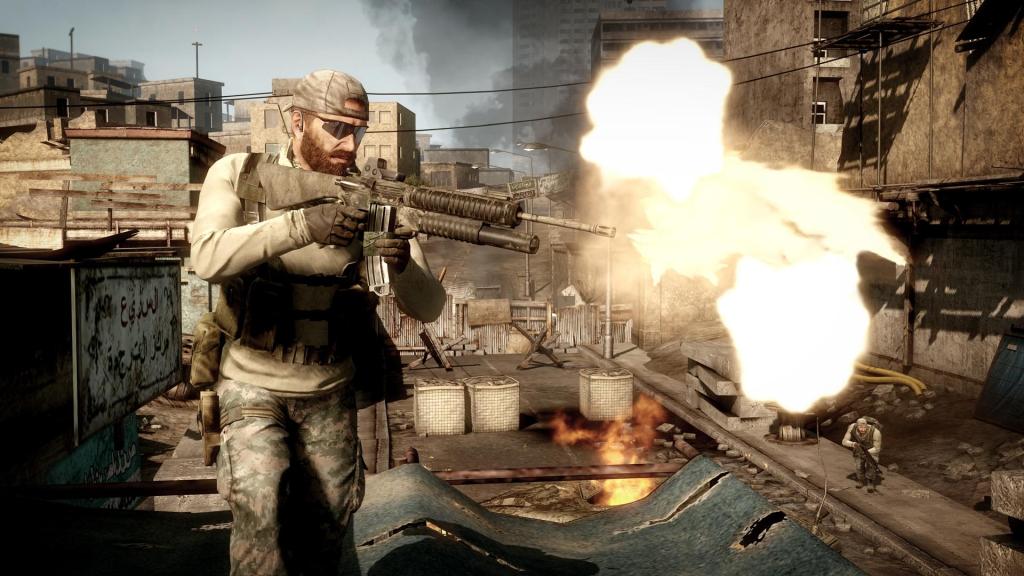
Medal of Honor’s Complicated Legacy and Saving Private Ryan’s Lasting Influence
While 2002’s Medal of Honor: Frontline was called the game of the year by many outlets, subsequent games in the series garnered decidedly more mixed receptions. 2003’s Medal of Honor: Rising Sun was no match for Call of Duty, just as 2004 ‘s Medal of Honor: Pacific Assault couldn’t hold a candle to Call of Duty 2 in the minds of many. As time went on, the Medal of Honor franchise attempted to mimic Call of Duty in more and more overt ways. The results could generously be described as mixed.
For a series that started out with a direct line to Saving Private Ryan, it’s a little ironic that Medal of Honor was eventually defined and defeated by a studio that was more willing to directly embrace that movie’s style, story, and best moments. Perhaps, the early Medal of Honor games weren’t in the best position to emulate Saving Private Ryan so directly from a technological and content standpoint, but there’s something sad about the ways that Medal of Honor initially tried to distinguish itself as more than a Saving Private Ryan adaptation have been lost slightly in favor of simply walking the path forged by one of the most influential films of the last 25 years. Allied Assault and the early Call of Duty games deserve the praise they’ve received, but it’s hard not to wonder what might have been if more games looked at how Medal of Honor initially distinguished itself and went for something different.
But even fallen (or mostly fallen) franchises can leave a lasting legacy. As far as Medal of Honor goes, nobody summarized its legacy quite so elegantly as Max Spielberg: the kid whose GoldenEye sessions helped inspire the development of the first Medal of Honor game.
“Medal of Honor is one of the few great marriages of game and film,” said Spielberg. “It was that first rickety bridge built between the silver screen and the home console.”
Maybe the first Medal of Honor games didn’t exactly recreate Saving Private Ryan, but they aimed for that level of success in a way that most studios would have never dreamed of. There are times when it’s easy to take for granted how video games can make the best movies come to life. What we should never forget are the contributions of the developers who turned our whispers of “Could you imagine playing a game that looks like that?” that we hoped wouldn’t echo in a crowded theater into the games we know and love today.

